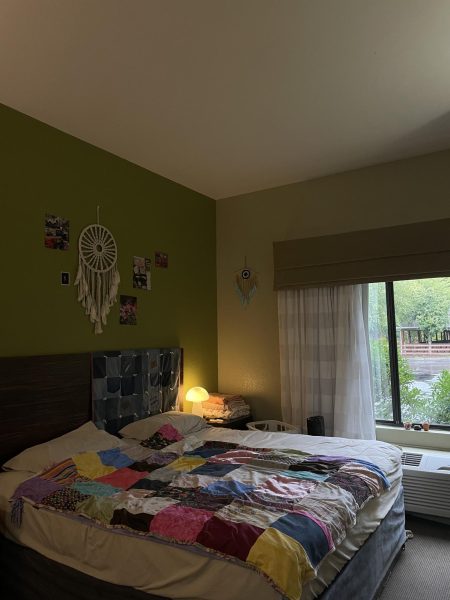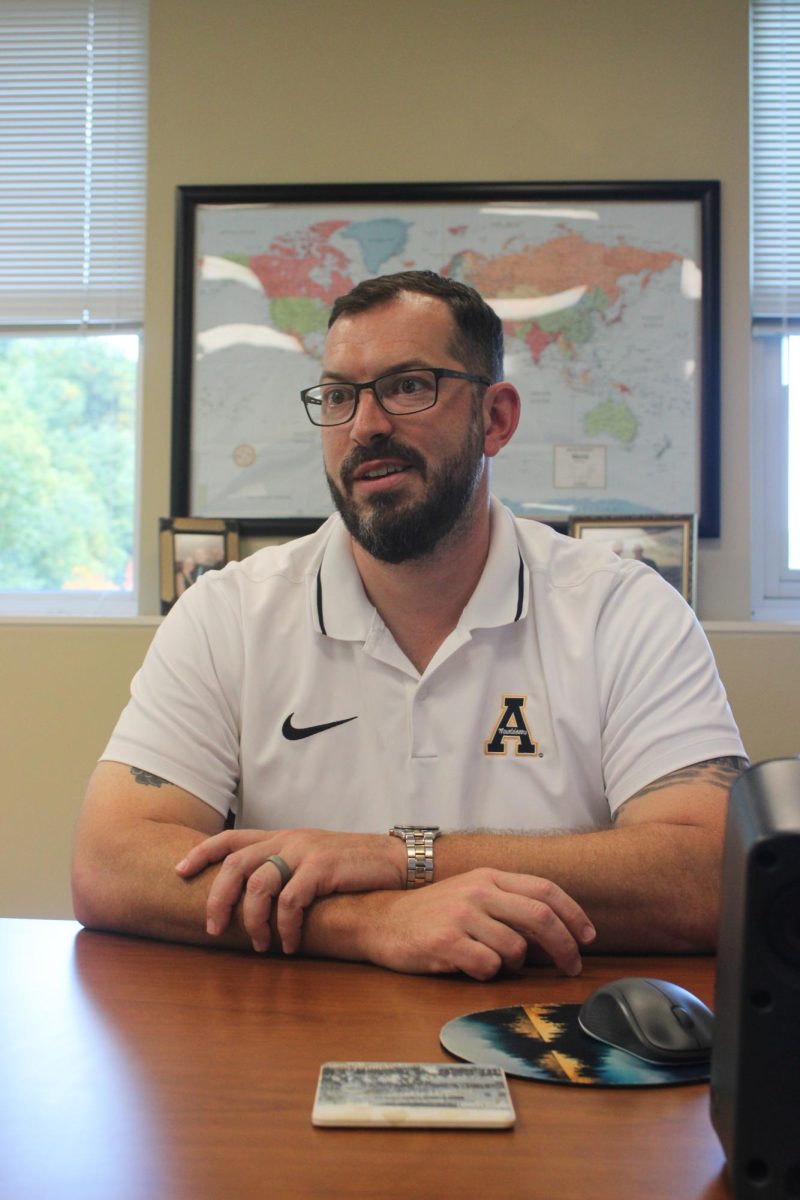App State began placing students who applied for on-campus housing in the Sleep Inn Hotel, located about half a mile from campus, in 2023. But this is not the first time App State has utilized hotels and other unorthodox housing solutions to make room for all its students.
During the fall semester of 1978, a staff writer for The Appalachian, Del Hunt, wrote a front page article with the headline “Dorm openings.”

“If Noah’s Ark could solve ASU student housing problems then it might be a welcome solution,” Hunt wrote in their opening line.
Hunt reported that for the second consecutive year, students were being housed in two motels near campus, Greene’s Motel and Watauga Motel, despite there being 110 rooms available in on-campus residence halls.
According to Hunt’s article, the Director of Housing Operations in 1978, Bill Sposato, said the excess of rooms on campus was caused by no-show students who had reserved rooms, creating the need to house some first-year students in motels.
An article published in The Appalachian the previous year reported that App State did not plan to house students in motels for more than one semester. Staff Writer Debbie Cook also spoke to Sposato, who said there were 100 students being housed in motels.
In 1989, Staff Writer David Peete reported in his article that 71 students were temporarily housed in activity rooms and lounges in residential halls at the start of the Fall semester.
Peete spoke to the Vice Chancellor for Student Development, David Mclntire, who said the temporary spaces were used because App State overbooked its residence halls each year to account for no-show students. Overbooked students were canceled out by no-show students, fulfilling the university’s desire to keep residence halls at 100% occupancy.
Peete graduated from App State in 1992 and said he wrote the article his freshman year because he was one of the temporarily displaced students. Peete is from Fort Myers, Florida, and said his parents were shocked and disappointed after driving 13 hours to App State to find out Peete would be staying in the lobby area of a residence hall. Peete himself doesn’t remember being too bothered.
“I mean, I’m sure it wasn’t great; I’m sure I was maybe a little upset about it,” Peete said. “But it just felt like I sort of had plenty of other things to do, including starting class.”
Peete said he does remember the constant noise that overwhelmed the hall, with so many excited first-years sharing the same space.
“The noise of the dorm, as you could imagine, just never stopped,” Peete said. “It was always music, and laughing, and just playing games in the hallway, and popping popcorn and it was just a mess. It was very hard to get any rest or sleep or whatever.”
Peete said after a week he came back to the dorm to find a note on his cot informing him of his new assigned room in Cone Hall across campus. He said he had no one to help him lug his belongings across campus.
Peete said it was a “rough start,” but the experience is memorable and he has nothing bad to say about his time as a Mountaineer.
Four years later, App State once again found itself with an abundance of students and a lack of rooms.
In 1993, News Editor Dawn McGuire reported in her article that students were being tripled up in rooms in East Hall, and others were placed in the lobbies of Frank and Bowie halls. This time, the culprit was delayed construction and renovation in Justice, Gardner and Coltrane halls.

Director of University Housing Brandon Nelson said the approach to housing students today differs greatly from years past.
“Where we’ve gotten stronger as a university is just like recognizing data points with particular students,” Nelson said.
University Housing no longer overbooks residence halls to compensate for no-show students. University Housing utilizes data from the admission’s checklist which first year students must complete to determine which students are likely to enroll and which seem like they may not attend.
“Did they sign up for orientation? Did they attend orientation? Did they do their prep class, which allows them to register? Did they do their housing contract?” Nelson said.
Nelson said the university now aims to have their residence halls 99% filled, rather than 100%, to account for roommate change requests and other issues that come up in the first few weeks of class.
In contrast to Greene’s Motel and Watauga Motel, Sleep Inn was implemented by University Housing as a permanent residence hall, not a temporary fix to housing shortages.
There are 139 students residing in Sleep Inn, and Nelson said some students chose to return to the hotel-style hall after living there the previous year.
Some additions and changes have been made to make the hotel feel more like a traditional residence hall and to accommodate student needs, such as the addition of a lounge area, extra washer and dryers, a kitchen and App State-themed decor.
Nelson said the two most important changes implemented were increasing the bandwidth of the building’s Wi-Fi and allowing one parking space per room.
“We kind of learned as we gathered feedback and tried to make adjustments where we were like, ‘Oh this would make sense to help here,’” Nelson said.
Jake Russolese, a junior history education major, said he lived at Sleep Inn last year after transferring to App State.
Russolese said he struggled in the beginning, especially when he lacked Wi-Fi in his room and had no place to park.
However, Russolese said the overall situation was not bad after the university began addressing problems.
“I kind of got used to it,” Russolese said. “I ended up not really being opposed to it because I was involved in a lot of extracurriculars, so I was outside of my room a lot.”
Russolese said one of the perks of living there was the furniture and appliances the room already had, including a TV, microwave and mini fridge.

First Carolina Management Hotels, a North Carolina-based company that owns hotels across the state, is still the owner of Sleep Inn and works with App State to house students. This, Nelson said, is why the hotel kept its furniture and appliances when it began housing students.
Russolese said another downside of living at Sleep Inn was a lack of connection he felt with other students, despite efforts from resident assistants to increase resident interaction.
“It wasn’t really like a dorm-style environment where people were walking around talking to each other,” Russolese said.
Ashlyn Parnell, a junior English major and current resident of Sleep Inn, said they have had a much different experience.
Although they were a little hesitant at the idea of staying at a hotel, Parnell said the mega-sized single room and constant interaction with other residents has made the experience comfortable and welcoming. Parnell’s RA organized a collage-making event, which initially brought the Sleep Inn residents together.
“We all bonded over it,” Parnell said. “And since then we’ve been inseparable.”
Parnell said they have not had any issues with the Wi-Fi since the university updated the system and any issues they have seen are typical to that of a traditional dorm. They said they would highly recommend to any first-year student to try living at Sleep Inn.
“I almost didn’t go to Sleep Inn and I would have been heavily devastated,” Parnell said. “I would have not known what I was missing out on.”
Nelson said the success of Sleep Inn is due to the university’s strong relationship with FCM Hotels, the RAs and staff of the hotel who are on-duty 24 hours a day and the maintenance staff that keeps operations running smoothly.
“Our facilities team — really all of them: residence life, facilities and admin — they care about this place like it’s their own home, and you can see it in the buildings,” Nelson said.

Para leer en español haz clic aquí.



